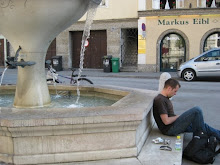Dover is generally known in the UK as an industrial port town. It is the departing point for ferries to France as it lies on the narrowest gap across the English Channel. Due to it's proximity to France, it's always been an important strategic location. It also has one of the oldest and most well-preserved castles in England that dates back to 1050.
Pics Here: http://picasaweb.google.co.uk/bribergey/DoverCastle?feat=directlink
The main reason for our visit to Dover was to visit the Dover Castle. The castle was originally founded by Romans, and later played a part in Saxon, Norman and Napoleonic times. It originally had two 80 foot Roman lighthouses, one of which still exists.
The most interesting part about the castle was it's purpose during the last 150-200 years. The castle has a series of underground tunnels, originally built to hide soldiers during the height of the Napoleonic Wars. They could shelter over 2000 men and were the only underground barracks ever built in Britain. During the second world war, they were upgraded with a military telephone exchange room. The switchboards were constantly in use and were used both as direct communication with navy vessels and direct air-sea rescue aircraft to pick up pilots shot down in the Channel. Later, the tunnels were used for government officials as an emergency shelter in case of a nuclear attack. It was soon discovered, however, that the chalk cliffs would not be strong enough to protect anyone from nuclear radiation.
Unfortunately, the tours of the underground tunnels were booked for the day, but we still spent the chilly afternoon exploring the castle grounds and the many buildings you can enter. The highlight was the main tower you can climb and the outstanding landscape that was created in order to protect the castle grounds.
Dover is also known for it's White Cliffs. Immediately outside of the city limits, the countryside opens to rolling fields that abruptly end at cliffs directly above the sea. Due to the fact that they are literally made of chalk, they shine white with accented lines of black flint. They cliffs are up to 350 feet high and they really do form a dramatic background to the sea and tiny pebble beaches formed in small coves below.
After dark, we decided to take the short drive up to Canterbury for dinner. We had visited Canterbury in June for a night, and we enjoyed the old center of the medieval town then and now. We found a very nice pub called The Dolphin due to a friend's recommendation and had some excellent food before driving back to London.
2.08.2010
Subscribe to:
Post Comments (Atom)









1 comment:
Thanks for the great information about Dover. It is not only a major port town in the UK for crossing the English Channel with ferry to france but it itself is a great tourist destination. I often visit the port to avail a ferry to france but unfortunately I could not make enough time to visit the great White Cliffs yet but I'm planning to do it on my next visit to Dover.
Post a Comment